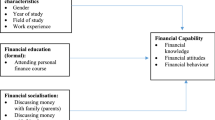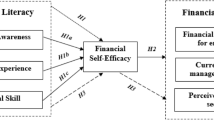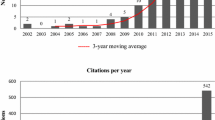Abstract
Financial education plays a significant role in poverty reduction and sustainable economic growth. It also increases individuals' financial well-being. Unfortunately, global financial literacy is low, and in developing countries, it is far below the global average. Nepal is a developing country with low financial literacy. Therefore, this study aimed to analyze the impact of financial literacy training on financial literacy levels and financial decisions among 399 randomly selected rural households in Bhojpur District, a rural area in Nepal. Multiple linear and logit regression models were used to analyze the data. The results revealed that financial literacy training increased the financial literacy level of training participants compared with that of non-participants. Education, financial literacy training, and migration of family members (personal migration history and plans to migrate) were other significant predictors. Respondents' financial and economic behavior was influenced by their financial literacy level, sex, age, education, family size, whether the respondent lives with parental family, and whether the respondent has migrated family members. The study suggested well-organized and inclusive financial literacy training program interventions to improve rural individuals' financial and economic decisions.



Similar content being viewed by others
Data and materials availability
The datasets used and/or analysed during the current study are available from the corresponding author on reasonable request.
References
Adiputra IG (2021) The influence of financial literacy, financial attitude and locus of control on financial satisfaction: evidence from the community in Jakarta. KnE Soc Sci. https://doi.org/10.18502/kss.v5i5.8848
Bandura A, Walters RH (1977) Social learning theory, vol 1. Prentice Hall, Englewood cliffs
Bourova E, Anderson ME, Ramsay I, Ali P (2018) Impacts of financial literacy and confidence on the severity of financial hardship in Australia. Australas Account, Bus Finance J 12(4):4–23. https://doi.org/10.14453/aabfj.v12i4.2
Bucher-Koenen T, Lusardi A, Alessie R, Van Rooij M (2017) How financially literate are women? An overview and new insights. J Consum Aff 51(2):255–283. https://doi.org/10.1111/joca.12121
Christelis D, Jappelli T, Padula M (2010) Cognitive abilities and portfolio choice. Eur Econ Rev 54(1):18–38. https://doi.org/10.1016/j.euroecorev.2009.04.001
Cucinelli D, Trivellato P, Zenga M (2019) Financial literacy: the role of the local context. J Consum Aff 53(4):1874–1919. https://doi.org/10.1111/joca.12270
Davoli M, Rodríguez-Planas N (2020) Culture and adult financial literacy: evidence from the United States. Econ Educ Rev 78:102013. https://doi.org/10.1016/j.econedurev.2020.102013
Dewi VI (2022) How do demographic and socioeconomic factors affect financial literacy and its variables? Cogent Bus Manag 9(1):2077640. https://doi.org/10.1080/23311975.2022.2077640
Ergün K (2018) Financial literacy among university students: a study in eight European countries. Int J Consum Stud 42(1):2–15. https://doi.org/10.1111/ijcs.12408
Faulkner A (2022) Financial literacy around the world: what we can learn from the national strategies and contexts of the top ten most financially literate nations. Ref Libr 63(1–2):1–28. https://doi.org/10.1080/02763877.2021.2009955
Finke MS, Howe JS, Huston SJ (2017) Old age and the decline in financial literacy. Manag Sci 63(1):213–230. https://doi.org/10.1287/mnsc.2015.2293
Gibson J, McKenzie D, Zia B (2014) The impact of financial literacy training for migrants. World Bank Econ Rev 28(1):130–161. https://doi.org/10.1093/wber/lhs034
Grohmann A, Klühs T, Menkhoff L (2018) Does financial literacy improve financial inclusion? Cross country evidence. World Dev 111:84–96. https://doi.org/10.1016/j.worlddev.2018.06.020
Gujarati D (1998) Basic econometrics, 3rd edn. McGraw Hill Book Company, New York
He C (2020) Financial literacy in developing countries. Soc Impact Res Exp (SIRE). https://repository.upenn.edu/sire/79
Johnson RA, Wichern DW (2007) Applied multivariate statistical analysis, 6th edn. Pearson Prentice Hall, Upper Saddle River, NJ
Kadoya Y, Khan MSR (2020) What determines financial literacy in Japan? J Pension Econ Finance 19(3):353–371. https://doi.org/10.1017/S1474747218000379
Khan F, Siddiqui MA, Imtiaz S (2022) Role of financial literacy in achieving financial inclusion: a review, synthesis and research agenda. Cogent Bus Manag 9(1):2034236. https://doi.org/10.1080/23311975.2022.2034236
Kim HH, Maurer R, Mitchell OS (2021) How financial literacy shapes the demand for financial advice at older ages. J Econ Age 20:100329. https://doi.org/10.1016/j.jeoa.2021.100329
Klapper L, Panos GA (2011) Financial literacy and retirement planning: the Russian case. J Pension Econ Finance 10(4):599–618. https://doi.org/10.1017/S1474747211000503
Klapper L, Lusardi A, Oudheusden PV (2015) Financial literacy around the world. World Bank, Washington DC
Lusardi A (2012) Numeracy, financial literacy, and financial decision-making (no. w17821). Nat Bur Econ Res. https://doi.org/10.3386/w17821
Lusardi A, Mitchell OS (2011a) Financial literacy around the world: an overview. J Pension Econ Finance 10(4):497–508. https://doi.org/10.1017/S1474747211000448
Lusardi A, Mitchell OS (2011) Financial literacy and planning: implications for retirement wellbeing (no. w17078). Nat Bur Econ Res. https://doi.org/10.3386/w17078
Lusardi A, Tufano P (2015) Debt literacy, financial experiences, and overv indebtedness. J Pension Econ Finance 14(4):332–368. https://doi.org/10.1017/S1474747215000232
Lusardi A, Mitchell OS, Curto V (2010) Financial literacy among the young. J Consum Aff 44(2):358–380. https://doi.org/10.1111/j.1745-6606.2010.01173.x
Maatta P (2022) Financial literacy statistics in 2022. https://dreammaker.co.uk/blog/financial-literacy-statistics/. Accessed 8 Dec 2022
Mohta A, Shunmugasundaram V (2023) Millennials’ financial literacy and risk behavior: evidence from India. Int Rev Econ. https://doi.org/10.1007/s12232-023-00425-8
Nguyen HV, Ha GH, Nguyen DN, Doan AH, Phan HT (2022) Understanding financial literacy and associated factors among adult population in a low-middle income country. Heliyon. https://doi.org/10.1016/j.heliyon.2022.e09638
Nguyen DT (2017) Factors affecting financial literacy of Vietnamese adults: a case study for Hanoi and nghe an. VNU J Econ Bus 33(2):59–73. https://js.vnu.edu.vn/EAB/article/view/4084
Nicolini G, Cude BJ, Chatterjee S (2013) Financial literacy: a comparative study across four countries. Int J Consum Stud 37(6):689–705. https://doi.org/10.1111/ijcs.12050
Nidar S, Bestari S (2012) Personal financial literacy among university students (case study at padjadjaran university students, Bandung, Indonesia). World J Soc Sci 2(4):162–171
Rosacker KM, Rosacker RE (2016) An exploratory study of financial literacy training for accounting and business majors. Int J Manag Educ 14(1):1–7. https://doi.org/10.1016/j.ijme.2015.11.002
Setiawan M, Effendi N, Santoso T, Dewi VI, Sapulette MS (2022) Digital financial literacy, current behaviour of saving and spending and its future foresight. Econ Innov New Technol 31(4):320–338. https://doi.org/10.1080/10438599.2020.1799142
Simonse O, Werf MV, Wilmink G (2017) Effective ways to advance responsible financial behaviour. https://www.wijzeringeldzaken.nl/bibliotheek-/media/pdf/English/Effective-ways-to-advance-responsible-behaviour.pdf
Stolper O (2018) It takes two to Tango: households’ response to financial advice and the role of financial literacy. J Bank Finance 92:295–310. https://doi.org/10.1016/j.jbankfin.2017.04.014
Tan E (2014) Human capital theory: a holistic criticism. Rev Educ Res 84(3):411–445. https://doi.org/10.3102/0034654314532
Thapa BS, Nepal SR (2015) Financial literacy in Nepal: a survey analysis from college students. NRB Econ Rev 27(1):49–74. https://doi.org/10.3126/nrber.v27i1.52567
Thongrak N, Chancharat S, Kijkasiwat P (2021) Financial literacy: does it improve well-being? A case study of farmers in Khon Kaen, Thailand. In: Environ, Soc, Govern Perspect Econ Dev Asia. Emerald Publishing Limited. https://doi.org/10.1108/S1571-03862021000029A022
West J (2012) Financial literacy education and behaviour unhinged: combating bias and poor product design. Int J Consum Stud 36(5):523–530. https://doi.org/10.1111/j.1470-6431.2012.01118.x
Wright RE (1995) Logistic regression: reading and understanding multivariate statistics. American Psychological Association, Washington DC
Yuesti A, Rustiarini NW, Suryandari NNA (2020) Financial literacy in the COVID-19 pandemic: pressure conditions in Indonesia. Entrepreneurship Sustain Issues 8(1):884. https://doi.org/10.9770/jesi.2020.8.1(59)
Zhou Y, Yang M, Gan X (2022) Education and financial literacy: evidence from compulsory schooling law in China. Q Rev Econ Finance. https://doi.org/10.1016/j.qref.2022.09.006
Acknowledgements
The authors would like to express profound gratitude to SaMi/HELVETAS Nepal staff members Sita Ghimire, Sanat Sapkota, and Pratibha Gyawali, SaMi/DEPROSC-Nepal staff member Sagar Bikram Basnet, district program co-ordinator Tek Bahadur Shrestha for providing an initial list of participants and non-participants, as well as creating an accessible environment for the field survey in Bhojpur District. Additionally, we would like to thank Editage (www.editage.com) for their English language editing services.
Funding
No funding was received for conducting this study.
Author information
Authors and Affiliations
Contributions
Conception and design were performed by SKK and IT. Data was collected by SKK. Modeling and data analysis were performed by AA and SKK. The first draft of the manuscript was written by SKK and AA and all authors commented on previous versions of the manuscript. All authors read and approved the final manuscript.
Corresponding author
Ethics declarations
Conflict of interest
The authors declare that they have no competing interests.
Ethical approval
The study was conducted in accordance with the guidelines approved by the Institutional Review Board for Human Research of Soka University (Date of approval: July 31, 2021; Approval No. 2021042).
Additional information
Publisher's Note
Springer Nature remains neutral with regard to jurisdictional claims in published maps and institutional affiliations.
Appendices
Appendix A
The goal of Safer Migration Project (SaMi), it’s training purpose, and selection criteria of training areas and participants.
Goal of the SaMi | Purpose of training | Selection of training area | Trainee selection criteria |
|---|---|---|---|
Migrants & their families are better protected by concerned Nepali institutions and benefit from decent work conditions abroad | Provide the financial knowledge and skill to family members of the migrant workers Encourage to open bank account, keep the record of income and expenses, making family budget, and saving Encourage to make a business plan, mobilization of available financial resources and invest in income generating activities for sustainable livelihood inside Nepal Consultation with family members in their social and phycological problems | Area should be highly dependent on remittance At least 80 percent participant should be from endogenous, dalit (backward caste), and marginalized people Ninety eight percent of participants should be female in average Suitable area that can divide four groups by different community | Age of participant should be between 16 to 50 One participant from one household (if there is more than one members is in foreign employment m their spouse can participate) Participant should be either wife or husband of foreign worker Majority of the participants should be endogenous, dalit (backward caste), and marginalized people Priority to those people who have no account in bank or financial institutions Participant should have basic knowledge of read and write Choose for those people who can regularly participate in training |
Appendix B
Questions measuring financial literacy.
1. Suppose you had Nepalese rupees (Rs.) 100 in a saving account and interest rate was 2% per year. After 5 years, how much do you think you would have in the account if you left the money to grow? (a) More than Rs. 102** (b) Exactly Rs. 102 (c) Less than Rs. 102 (d) Do not know (e) Refuse to answer |
2. Imagine that the interest rate on your savings account was 1% per year and inflation was 2% per year. After 1 year, how much would you be able to buy with the money in this account? (a) More than today (b) Exactly the same (c) Less than today** (d) Do not know (e) Refuse to answer |
3. Please tell me whether this statement is true or false. “Buying a single company’s stock usually provides a safer return than stock mutual fund.” (a) True (b) False** (c) Do not know (d) Refuse to answer |
Rights and permissions
Springer Nature or its licensor (e.g. a society or other partner) holds exclusive rights to this article under a publishing agreement with the author(s) or other rightsholder(s); author self-archiving of the accepted manuscript version of this article is solely governed by the terms of such publishing agreement and applicable law.
About this article
Cite this article
Karki, S.K., Andaregie, A. & Takagi, I. Impact of financial literacy training on the financial decisions of rural households in Nepal. Int Rev Econ (2023). https://doi.org/10.1007/s12232-023-00438-3
Received:
Accepted:
Published:
DOI: https://doi.org/10.1007/s12232-023-00438-3




